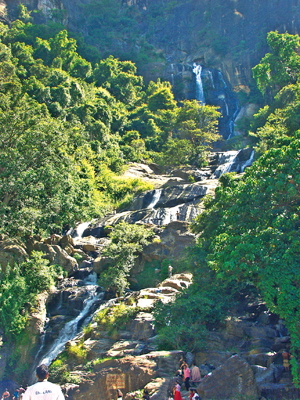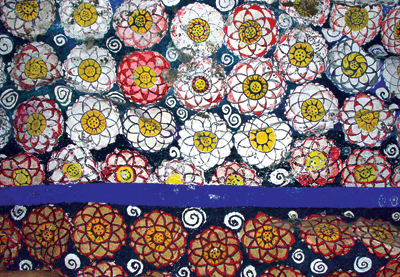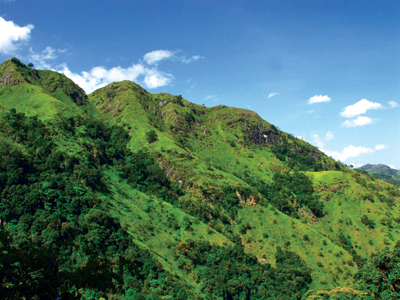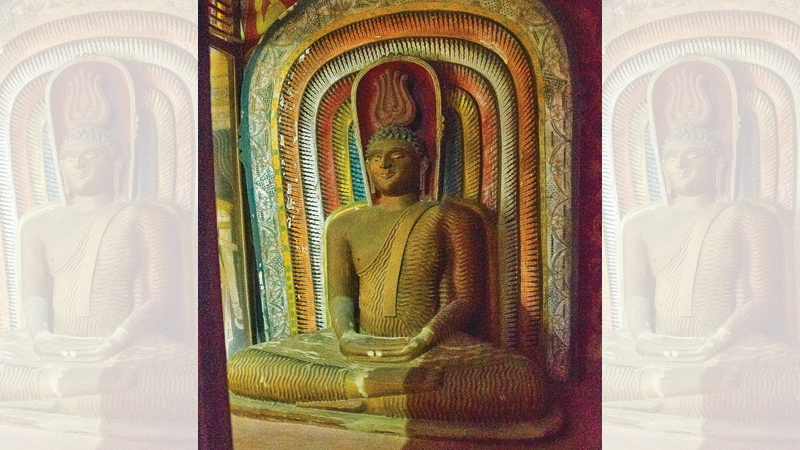 The imposing Moneragala or Peacock Hill which stands as a lone ‘watch tower’, looms before the traveller coming from Wellawaya-Bibile. From Wellawaya to Moneragala, the distance is not far. When one drives or walks through the woodland mountain frontier, actually one goes through the long, but lonely glimpses of history and legend too.
The imposing Moneragala or Peacock Hill which stands as a lone ‘watch tower’, looms before the traveller coming from Wellawaya-Bibile. From Wellawaya to Moneragala, the distance is not far. When one drives or walks through the woodland mountain frontier, actually one goes through the long, but lonely glimpses of history and legend too.
The other rock named Obbecotta, comes into view. On seeing these magnificent rocky mountains, I was reminded of a fascinating tale woven around Prince Vijaya and Kuveni in the Yakkini princess whom Vijaya wedded and later deserted.
Upon Kuveni’s banishment by Vijaya, she in utter vendetta, cursed him with these words: “Though I perish at the hands of my people, yet will show my love for them, while one of my breasts shall forever be the twain, shall be dry and bountiful, the greater of nourish not for all time.”

The Ravan Ella – the waterfall cascades from rocky boulders
Upon these blasphemous words, it is said in folklore of Moneragala that the rock of Obbecotta became a parched rock to this day, resembling one of Kuveni’s full breasts. Then from the other ‘bountiful breast’ of Kuveni, this same legend says, as prophesied by her, sprang up a perennial spring of ever-flowing water. This spring, old folks say, still flows down perennially from the heights of Moneragala.
Now the scene switches on the verdant Ravan Ella mountain frontier steeped in legends of Ravana-Sita. From Moneragala via Wellawaya to this scenic salubrious mountain country of Ravana-Ella is not a far cry. From Wellawaya, the distance to Bandarawela through the mountain road of Ella-Wellawaya is about 60 kilometres.
Mountain road
This Ella-Wellawaya road encountering elbow bends and precipitous inclines runs through the beautiful mountain scenery. The mountain road was a relic of a rugged track where in those years gone by, tavalams from Hambantota loaded with bags of salt limped their weary way to Badulla and Bandarawela.
One of the finest and beautiful mountainscapes that could be viewed in the country is the Ravana Falls and the breathtaking Ella gap filled with wondrous and panoramic views embracing this vast mountain country. Ravana Falls is redolent of the Ravana-Sita’s hideout where Sita’s enclaved hideout, had been amid this cascading, but enticing water-fall. Ravana Ella lies between half-way of the Ella-Wellawaya mountain road.
From this lofty height of the rocky crag, cascade tiny, but silvery ribbons of water which as it comes down, becomes broader and broader to plunge finally in a roar into the roaring rock pools below stocked with rock boulders.

The floral design of lotus flowers on the ceiling of the Dova rock cave temple
As to the hoary legend of Rawana-Sita, it says that Sita was kept a virtual prisoner in a cave called Ravana Guhawa. It seems according to this oft repeated tale, that Sita being a ravishing beauty, was kept as a captive in a cave close to Ravana Ella where she stealthily made her way along a hidden pathway to the cool gushing waters to have her bath.
On the precipitous inclines and never wrecking bends of the Ella-Wellawaya mountain highway, near its 30th kilometre post, lies Ravanagama. From there lies a decrepit, but metalled road that leads to another historical spot called Ravana Ella Raja Maha Vihara.
At its turn off, Kirindi Oya meanders lazily, gamboling over the rocks and rock pools in a big shout to meet its mainstream in the deep, but abysmal gorge below. The distance along the road to the Vihara is about two kilometres.
Kirindi Oya
We walked it out with some villagers who joined us. They narrated to me wonderful tales connected with the Ravana Ella and Ravana Galguhawa. Such tales beguiled our time and we did not feel any weariness. This Kirindi Oya which rises in the Bandarawela-Pannawela massif joins the Bambaragala Falls. The power house of the Uma Oya Development Project is being constructed in this area off the Ella-Wellawaya highway.
Sandwiched between this Ravana Ella Gap and the Ravana mountain range is the Ravan Ella Raja Maha Vihara. A few feet away along a rugged, but a cobbled pathway ridged by a tiny rivulet is the rock cave temple.
A huge rock boulder looms, in which harbours Buddha statues. Its built-in-walls in its front elevation are constructed of stone masonry. In the rock cave shelter, its cave ceiling bears paintings of floral designs, some designs depicting the lotus in full bloom have defected, as there is a leak from the ceiling which drips onto the paintings.

One of the seated Buddha statues of the Ravana Ella Raja Maha Vihara
These paintings date back to the Kandyan period. Tradition holds that the famed King Valagamba of the 1st century BC used to take asylum in his exile (during foreign invasions) by sheltering himself in ancient rock caves, so this tale is woven around this rock cave shelter at Ravana Ella Raja Maha Vihara, where he is said to have lived and built the cave temple.
Pointing to a crag overhanging the Ravana Guhawa, the chief incumbent of the temple said that it was the cave where Ravana had lived. From here, there was a secret pathway leading to the Ravana Ella Water Falls where Ravana went for his bath, while Sita’s hideout was lying close to it. There is a tortuous, but a precipitous rugged path from the foot hill of the rock cave to make its uphill ascent arduous. Many adventure seeking youth had climbed this rock to see the Ravana Gal Guhawa.
Research into prehistory
The late Dr. P.E.P. Deraniyagala, a pioneer Director of National Museums, had done considerable research into the prehistory and fossil remains in the Ravana Guhawa. Dr. Deraniyagala had taken lodging at this rock temple for his scholastic investigations. He also had taken stone implements, and other faunal remains for his perusal.

A mountain landscape near the Ravana mountain range
The Ella Rest House is a bewitching spot surrounded by the Ravana Ella mountainscape from which perch, one could have a marvellous view of the plains and mountain ranges.
From Ella on the road to Bandarawela, there is still another historical spot called the Dowa Rock cave temple. It’s about eight kilometres from Bandarawela. Below an escarpment abutting the main road, is this Dowa Rock Temple.
On a large outcrop of a boulder of rock that overlooks this rock temple, lies a standing Buddha statue carved out on the face of the rock boulder itself. The Buddha statue is carved out on the rock in high relief. Its height is 36 feet. The headdress is dotted, and the right hand is held in the form of the Abhaya Mudra, meaning freedom of fear or fearlessness.
This Mudra is a symbolic form of expression etched in the hands of the Buddha statues. In the statue, the left hand is covered by the robe. The icon appears to have been incomplete and hence it is called ‘Kumbal Pilima’ (as referred to in Dr. Nandadeva Wijesekera’s ‘Ancient Sinhala Sculpture’).
In the rock cave temple which is housed below the boulder where the Buddha statue lies, are found, reclining Buddha statues and the walls and ceilings of the shrine room are depicted with paintings reminiscent of Jataka stories of Buddhist origin. It is a popular place of worship by both local and foreign tourists.









